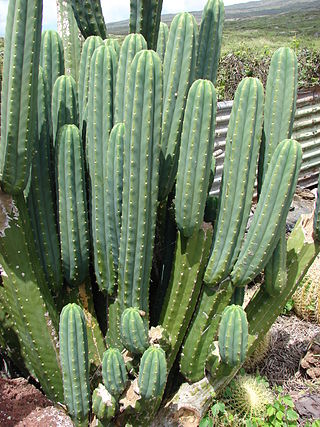
Lupinus polyphyllus, the large-leaved lupine, big-leaved lupine, many-leaved lupine, blue-pod lupine, or, primarily in cultivation, garden lupin, is a species of lupine (lupin) native to western North America from southern Alaska and British Columbia and western Wyoming, and south to Utah and California. It commonly grows along streams and creeks, preferring moist habitats.

Lupinus, commonly known as lupin, lupine, or regionally bluebonnet etc., is a genus of plants in the legume family Fabaceae. The genus includes over 199 species, with centers of diversity in North and South America. Smaller centers occur in North Africa and the Mediterranean. They are widely cultivated, both as a food source and as ornamental plants, but are invasive to some areas.

Lupinus albus, commonly known as the white lupin or field lupine, is a member of the genus Lupinus in the family Fabaceae. It is a traditional pulse cultivated in the Mediterranean region.

Adenium obesum, more commonly known as a desert rose, is a poisonous species of flowering plant belonging to the tribe Nerieae of the subfamily Apocynoideae of the dogbane family, Apocynaceae. It is native to the Sahel regions south of the Sahara, tropical and subtropical eastern and southern Africa and also the Arabian Peninsula. Other names for the flower include Sabi star, kudu, mock azalea, and impala lily. Adenium obesum is a popular houseplant and bonsai in temperate regions.

Lupinus perennis is a flowering plant in the family Fabaceae.
Lupinus kunthii is a species of legume in the family Fabaceae. It is endemic to Ecuador. Its natural habitat is subtropical or tropical high-altitude grassland.
Lupinus smithianus is a species of legume in the family Fabaceae. It is found in Ecuador and Colombia. Its natural habitat is subtropical or tropical high-altitude grassland. It is most commonly found in the months of August, April, and July.

Syzygium guineense is a leafy forest tree of the family Myrtaceae, found in many parts of Africa both wild and domesticated. Both its fruits and leaves are edible; the pulp and the fruit skin are sucked and the seed discarded. It is sometimes called "waterberry", but this may also refer to other species of Syzygium.

Trichocereus macrogonus var. pachanoi is a fast-growing columnar cactus found in the Andes at 2,000–3,000 m (6,600–9,800 ft) in altitude. It is one of a number of kinds of cacti known as San Pedro cactus. It is native to Ecuador and Peru, but also found in Argentina, Bolivia, Colombia, Chile and Venezuela and cultivated in other parts of the world. Uses for it include traditional medicine and traditional veterinary medicine, and it is widely grown as an ornamental cactus. It has been used for healing and religious divination in the Andes Mountains region for over 3,000 years.
Lupinus andersonii is a species of lupine known by the common name Anderson's lupine.

Lupinus brevicaulis is a species of lupine known by the common names shortstem lupine and sand lupine. It is native to the southwestern United States, including Oregon, California, Nevada, Utah, Colorado, Arizona, and New Mexico, where it grows in many types of sandy habitat.
Lupinus saxosus is a species of lupine known by the common name rock lupine. It is certainly native to eastern Washington, eastern Oregon, and the northeast corner of California,where it grows in sagebrush and other habitat. It may also be native to Idaho and Nevada.

Flacourtia indica (known commonly as ramontchi, governor's plum and Indian plum, is a species of flowering plant native to much of Africa and tropical and temperate parts of Asia. It has various uses including, folk medicine, fuel, animal food and human food.

Oreocereus trollii, commonly known as the Old Man of the Andes cactus, is a species of cacti native to Argentina and Bolivia. Though listed as Least Concern by the IUCN, the plant is collected extensively, and in some areas is threatened.
Lupinus jaimehintonianus, commonly known as chepil de la lluvia in Spanish, is a species of lupine that is native to southwest Mexico.
Lupinus eremonomus is a species of lupine native to Venezuela. It is a shrub that grows in the montane tropical biome.

Lupinus arvensis is a species of lupine that is native to Colombia, Ecuador, and Venezuela. It is a subshrub that grows in a montane tropical biome.
Lupinus prunophilus, commonly known as the hairy bigleaf lupine or chokecherry lupin, is a medium-sized herbaceous plant that grows in the Great Basin and other parts of the U.S. interior between the Sierra-Nevada and the Rockies. It is a close relative and very similar to Lupinus polyphyllus and is considered a subspecies by some botanists.

Lupinus caudatus is a widespread species of wildflower in genus Lupinus from western North America known by the common names tailcup lupin and spurred lupin. It is distinctive for the short spur on its purple-blue flowers, for which it is named. Because of its wide distribution and toxicity it commonly causes poisonings of susceptible livestock such as horses, cattle, and sheep, though it is eaten without harm by wild herbivores like deer and elk. It is generally found from the Coastal Ranges and Sierra Nevada Mountains in the west to the Rocky Mountains in the east.
Lupinus vallicola is a flowering plant in the genus Lupinus.












